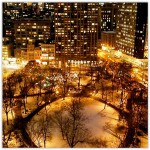 Madison Square is formed by the intersection of Fifth Avenue and Broadway at 23rd Street in the New York City borough of Manhattan. The square was named for James Madison, fourth President of the United States.
Madison Square is formed by the intersection of Fifth Avenue and Broadway at 23rd Street in the New York City borough of Manhattan. The square was named for James Madison, fourth President of the United States.
The focus of the square is Madison Square Park, a 6.2-acre (2.5-hectare) public park, which is bounded on the east by Madison Avenue (which starts at the park’s southeast corner at 23rd Street); on the south by 23rd Street; on the north by 26th Street; and on the west by Fifth Avenue and Broadway as they cross.
The park and the square are at the northern (uptown) end of the Flatiron District neighborhood of Manhattan. The use of “Madison Square” as a name for the neighborhood has fallen off, and it is rarely heard.[citation needed] The neighborhood to the north and west of the park is NoMad (“NOrth of MADison Square Park”) and to the north and east is Rose Hill.
Madison Square is probably best known around the world for providing the name of Madison Square Garden, a sports arena and its successor which were located just northeast of the park for 47 years, until 1925. The current Madison Square Garden, the fourth such building, is not in the area. Notable buildings around Madison Square include the Flatiron Building, the Toy Center, the New York Life Building, the New York Merchandise Mart, the Appellate Division Courthouse, the Met Life Tower, and One Madison Park, a 50-story condominium tower.
Madison Square can be reached on the New York City Subway via local service on the BMT Broadway Line (N Q R trains) at the 23rd Street station. In addition, local stops on the IRT Lexington Avenue Line (4 6 <6> trains) and IND Sixth Avenue Line (F M trains) are one block away at Park Avenue South and Sixth Avenue, respectively.
HISTORY
The area where Madison Square is now had been a swampy hunting ground, and first came into use as a public space in 1686. It was a Potter’s Field in the 1700s. In 1807, “The Parade”, a tract of about 240 acres (97.12 hectares) from 23rd to 34th Streetsand Third to Seventh Avenues, was set aside for use as an arsenal, a barracks, and a drilling area. There was a United States Army arsenal there from 1811 until 1825 when it became the New York House of Refuge for the Society for the Protection of Juvenile Delinquents, for children under sixteen committed by the courts for indefinite periods. In 1839 the building was destroyed by fire. The size of the tract was reduced in 1814 to 90 acres (36.42 hectares), and it received its current name.
In 1839, a farmhouse located at what is now Fifth Avenue and 23rd Street was turned into a roadhouse under the direction of William “Corporal” Thompson (1807–1872), who later renamed it “Madison Cottage”, after the former president. This house was the last stop for people travelling northward out of the city, or the first stop for those arriving from the north. Though Madison Cottage itself was razed in 1853 to make room first for Franconi’s Roman Hippodrome and then for the Fifth Avenue Hotel, Madison Cottage ultimately gave rise to the names for the adjacent avenue (Madison Avenue) and park, which are therefore only indirectly named after President James Madison.
The roots of the New York Knickerbocker Base Ball Club, one of the first professional baseball teams, are in Madison Square. Amateur players began in 1842 to use a vacant sandlot at 27th and Madison for their games and, eventually, Alexander Cartwright suggested they draw up rules for the game and start a professional club. When they lost their sandlot to development, they moved to Hoboken, where they played their first game in 1846.

